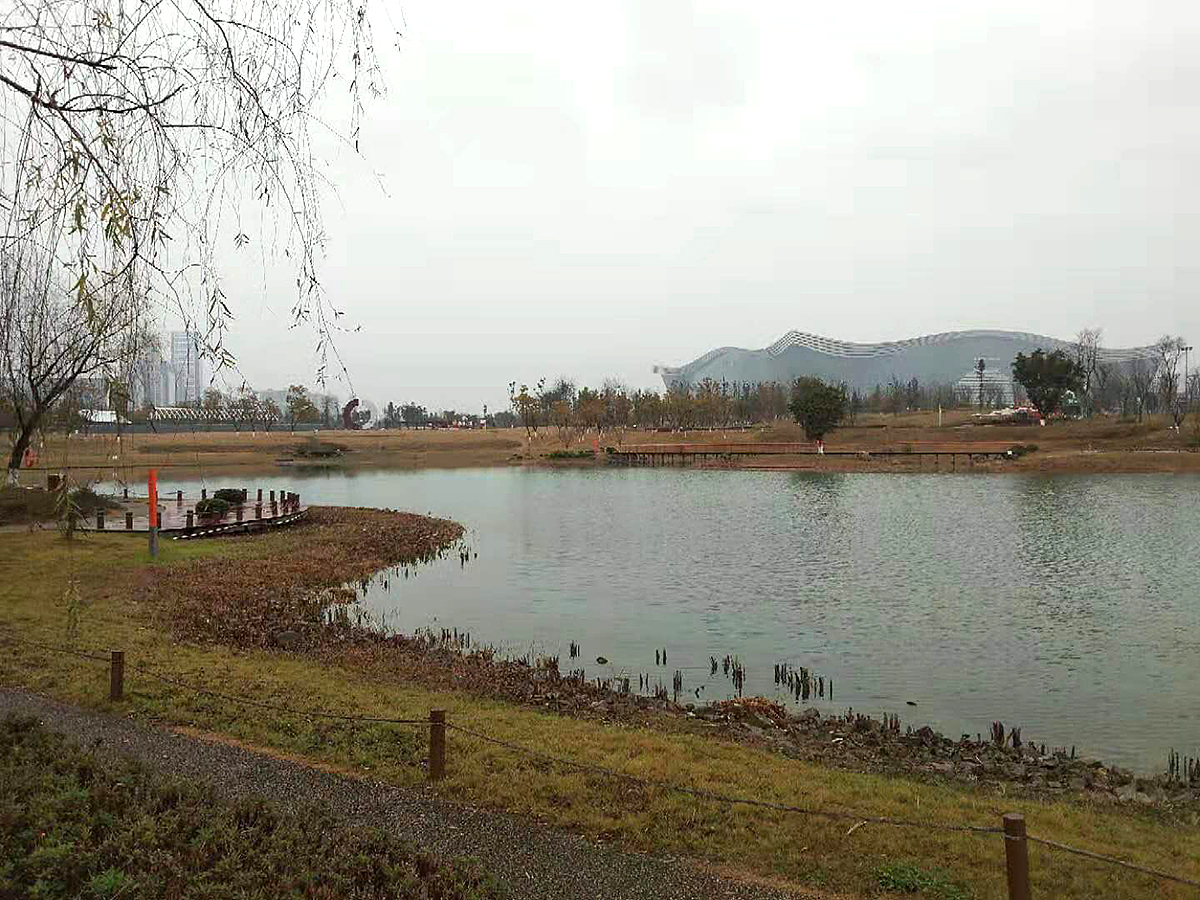by Steven Bonta
for shanghaibirding.com

In late January I set off with my wife to Yunnan, intending to spend a couple of weeks in sunny, subtropical Xishuangbanna, birding and touring. No sooner had we arrived in Kunming, than the vague unease over the coronavirus afflicting Wuhan crystalized into full-fledged panic. Overnight, stores, parks, and public places shut down, airports, streets, and train stations emptied, and breath masks came out. Not just Wuhan and neighboring cities, but virtually all of China went into lockdown, with more than a billion people hiding indoors.
At the first opportunity, we returned to Chengdu and the relative security of my wife’s apartment. On my first day in Chengdu, I resolved to go forth and visit some familiar local parks and bird habitat, curious about the effects of the lockdown on China’s birdlife. Following is my account of that day, and the birds.
Chengdu, like Kunming (and, I imagine, the rest of China), is a virtual ghost town, with the hysteria over the coronavirus keeping nearly everyone indoors, hoarding food and only venturing forth furtively to buy food at the one or two stores still open, faces covered with masks. The fear is palpable, and the only thing missing are cinematic zombies. The avenues and streets of this enormous metropolis, usually choked with noisy, chaotic traffic, are nearly empty, and most of the jetliners are gone from the sky. Nothing like this has ever happened in world history—a vast country, holding roughly one fifth of the world’s population, paralyzed with fear.
So I did the only rational thing: I strapped on my backpack and binoculars, and headed out with my wife to see how the birds were faring during the apocalypse. After all, birds across China have become accustomed to the obnoxious behavior of the Chinese, many of whom regard them as fit only to be chased, harassed, trapped, eaten, and otherwise stressed; this is why birds here are, for the most part, remarkably wary. I have assumed that this state of affairs has been the norm in China for at least a thousand years; now it was time to see if, in the sudden absence of people, bird behavior would change accordingly (a few years ago, the History Channel produced a fascinating miniseries called Life After People in which it was speculated how the world would change if people suddenly disappeared; never did I imagine I would get to witness something akin, even if temporary).
With the weather overcast and intermittently drizzly, we decided to limit our walk to the park and riverfront near my wife’s apartment building, where on a typical walk, I can find 18–20 species. I noticed that the big heron rookery on the river island nearby was not as clogged with birds as it usually was. Roughly 50 Grey Heron and one or two Little Egret were hanging out there—far less than the usual number. The reason soon became apparent as we walked along the river—the birds were feeding all up and down the river in much larger numbers than usual. With none of the usual noisy pedestrians and throngs of fishermen to harass them, they were enjoying unfettered access to all the fish, in some cases squabbling like seagulls over their catches.
In the park itself—almost devoid of people except for a few elderly, some of whom weren’t wearing masks and didn’t seem to care about all the craziness (after all, they’ve seen much worse)—the birds were everywhere. White-browed Laughingthrush, usually shy habitués of dense thickets and foliage, were foraging openly on the deserted lawns in large flocks. Chinese Grosbeak, normally perched high in trees away from stone-throwing children, unleashed dogs, and other harassers, were mixing with flocks of Eurasian Tree Sparrow on the ground. And birds that I seldom or never find in this urban setting were also about: Rosy Pipit, Olive-backed Pipit, and Plumbeous Water Redstart. On this part of the river, Mallard flocked, along with a small group of Chinese Pond Heron, another bird relatively scarce in this area. Further downstream, I saw Common Sandpiper and Little Ringed Plover. After a walk of only a little over an hour, covering a mile at most, I had 29 species and had noted a lot of new behavior patterns.
On the other hand, some birds did not appear to notice that anything was amiss. One of my favorite Chinese birds, the endearing and intricately-patterned Black-throated Bushtit, is friendly and curious in normal times, and today they were no different. These diminutive, energetic birds came flocking to my phishing wherever I walked, perching close by in sizable flocks, curious and unafraid.
Unfortunately, on the way back, I noted some activity that served to remind why the birds of China are so remarkably skittish: a middle-aged man with a slingshot stood shooting at sparrows and bulbuls, shouting angrily at them all the while, doubtless under the illusion that the birds are somehow responsible for this disaster. After all, China has embarked on bird pogroms before, scapegoating them for disease outbreaks and other calamities.
Anyway, I plan to make further forays, to Bailuwan Wetland, a major eBird hotspot only a few miles from my wife’s apartment, and other less urban areas, in the coming days, to see how the wildlife in such places is faring. During my last visit to Bailuwan little more than a week ago, I was watching the large flock of Ferruginous Duck that winters there, along with several other species of waterfowl, when along came a Chinese family. The father immediately began urging his children to scare up all the ducks so they could watch them fly, completely indifferent to the foreigner who was trying to observe them. They proceeded to shout and scream and thoroughly scare up hundreds of waterfowl. I expect that the coronavirus has purchased those birds a temporary reprieve from that kind of harassment.
Postscript: My wife and I did indeed visit Bailuwan Wetland Park the following day, and found it empty. As anticipated, the Ferruginous Duck, along with Eurasian Coot and Common Moorhen, were enjoying the unwonted tranquility. The surrounding woods were also birdier than usual, with even a shy Chinese Hwamei making an appearance alongside a flock of laughingthrushes.
At the time of this writing, the initial hysteria seems to be subsiding, with more and more people coming out of hiding, but the parks are still empty and the birds are still enjoying this interlude of relative freedom from harassment. This morning’s walk along the river yielded a very robust 34 species.
PHOTOS




Interesting!
Thank you. For those of us who visit Chengdu on occasion [I was there in October], it would be great if you could edit by adding the names “the park and riverfront” near your wife’s apartment as well as other sites to which you made reference.
Isnt this missing the point ?
Yes the Chinese attitude to bird life is appalling, and urban birding can be fun.
But when your host governments advice is to venture out as little as possible. Surely its irresponsible for a foreigner to travel around birding. And dangerous for you also.
I’m all for a never say die birding spirit, but this seems more of a ‘determined to die’ one, if not for you, then your neighbours.
According to the Wikipedia article on the Wuhan coronavirus, there are restrictions on outdoor movement of citizens in some parts of China, but Chengdu doesn’t appear to be among the places that have implemented restrictions.
https://en.wikipedia.org/wiki/2019%E2%80%9320_Wuhan_coronavirus_outbreak#Outdoor_restrictions
Edna, the area referred to is the network of parks (most of them along rivers) in the area of the Global Center. There are many individually-named parks, but they all are pretty much connected by walking and biking trails.
Conditions vary across China. In Chengdu, when I was there a week ago, it was perfectly safe to walk around and look at birds. The coronavirus is certainly a crisis, but it still obeys the basic norms of contagion, which require contact with people or contaminated areas.
Really enjoyed this article. As a bird lover who has spent a lot of time working in China and birding on the occasional weekend, you really captured the essence of a country and it’s people pretty much oblivious to the beauty and allure of living, breathing and flying birds. Keep spreading the bird love. Miracles may happen and attitudes may change.